1993 PONTIAC BONNEVILLE fuel
[x] Cancel search: fuelPage 175 of 322
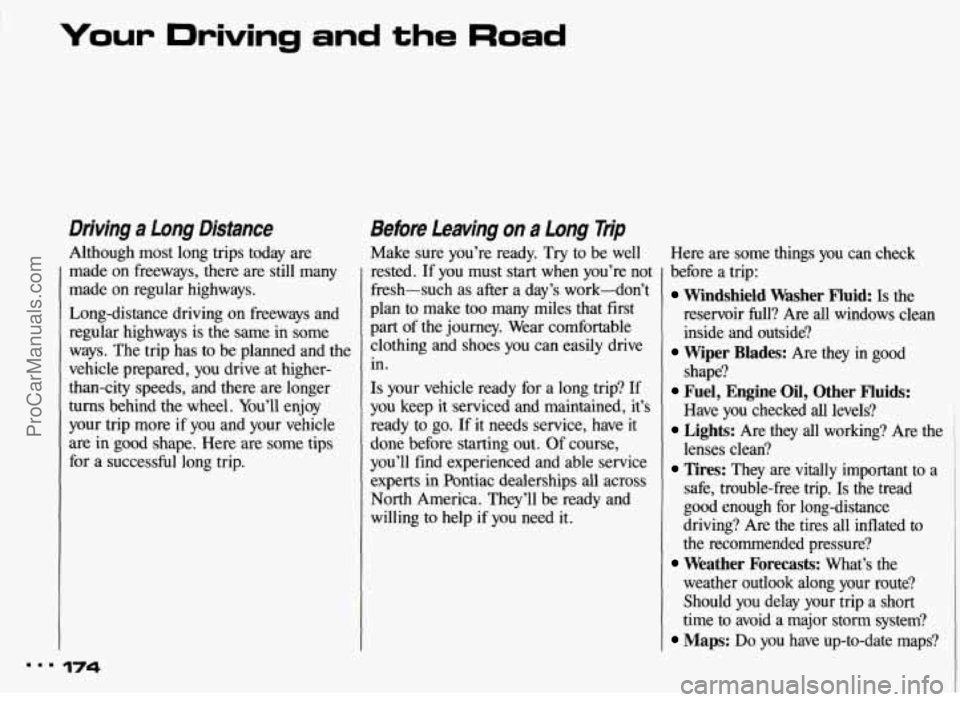
Your Driving and the Road
Driving a Long Distance
Although most long trips today are
made on freeways, there are still many
made on regular highways.
Long-distance driving on freeways and
regular highways
is the same in some
ways. The trip has to be planned and the
vehicle prepared, you drive
at higher-
than-city speeds, and there are longer
turns behind the wheel. You’ll enjoy
your trip more if
you and your vehicle
are in good shape. Here are some tips
for a successful long trip.
174
Before Leaving on a Long Trip
Make sure you’re ready. Try to be well Here are some things you can check
rested. If you must start when you’re not
fresh-such as after a day’s work-don’t
plan to make too many miles that first
part of the journey. Wear comfortable
clothing and shoes you can easily drive
in.
Is your vehicle ready for a long trip? If
you keep it serviced and maintained, it’s
ready to go. If it needs service, have it
done before starting out.
Of course,
you’ll find experienced and able service
experts in Pontiac dealerships all across
North America. They’ll be ready and
willing to help if you need it. before
a trip:
Windshield Washer Fluid: Is the
reservoir full? Are all windows clean
inside and outside?
shape?
Have you checked all levels?
lenses clean?
safe, trouble-free trip.
Is the tread
good enough for long-distance
driving? Are the tires all inflated to
the recommended pressure?
weather outlook along your route?
Should you delay your trip a short
time to avoid a major storm system?
Maps: Do you have up-to-date maps?
Wiper Blades: Are they in good
Fuel, Engine Oil, Other Fluids:
Lights: Are they all working? Are the
Tires: They are vitally important to a
Weather Forecasts: What’s the
ProCarManuals.com
Page 183 of 322

Your Driving and the Road
If bu’re Caught in a Blizzard
(CONT)
Run your engine only as long as you
must. This saves fuel. When you run
the engine, make it go a little faster
than just idle. That
is, push the
accelerator slightly. This uses less fuel
for the heat that you get and it keeps
the battery charged. You will need a
well-charged battery to restart the
vehicle and possibly for signaling later
on with your headlights. Let the heater
run for a while. Then,
shut the engine off and close
the window almost all the way to
preserve the heat.
Start the engine
again
and repeat this only when you
feel really uncomfortable from the
cold. But do it as little as possible.
Preserve the fuel as long as you can.
To help keep warm, you can get out of
the vehicle and do some fairly
vigorous exercises every half-hour
or
so until help comes.
If You’re Stuck in Deep Snow
This manual explains how to get the
vehicle out of deep snow without
damaging it. See the
Index under
Rocking Your Whicle.
ProCarManuals.com
Page 184 of 322
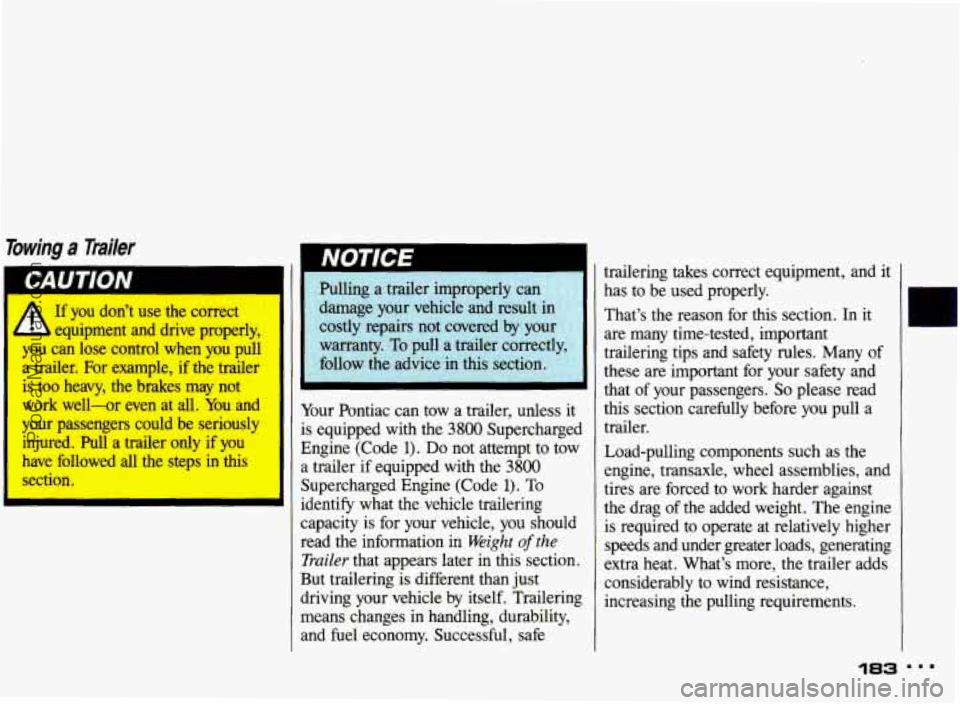
Towing a Tmiler
I
If you don't use the correct
equipment and drive properly,
you can lose control when you pull
a trailer. For example, if the trailer
is too heavy, the brakes may not
work well-or even at all. You and
your passengers could be seriously injured. Pull a trailer only if you
have followed all the steps in this
section.
NOTICE
I I; Pulling a trailer improperly can : __
damage your vehicle and result in' ;'
costly repairs not covered by your
follow the advice in this section.
Your Pontiac can tow a trailer, unless it
is equipped with the
3800 Supercharged
Engine (Code
1). Do not attempt to tow
a trailer
if equipped with the 3800
Supercharged Engine (Code 1). To
identify what the vehicle trailering
capacity is for your vehicle,
you should
read the information in
Weight of the
Trailer that appears later in this section.
But trailering is different than just
driving your vehicle by itself. Trailering
means changes in handling, durability,
and fuel economy. Successful, safe trailering
takes correct equipment, and it
has to be used properly.
That's the reason for this section.
In it
are many time-tested, important
trailering tips and safety rules. Many
of
these are important for your safety and
that of your passengers.
So please read
this section carefully before you pull a
trailer.
Load-pulling components such as the
engine, transaxle, wheel assemblies, and
tires are forced to work harder against
the drag of the added weight. The engine
is required to operate at relatively higher
speeds and under greater loads, generating
extra heat. What's more, the trailer adds
considerably to wind resistance,
increasing the pulling requirements.
ProCarManuals.com
Page 222 of 322
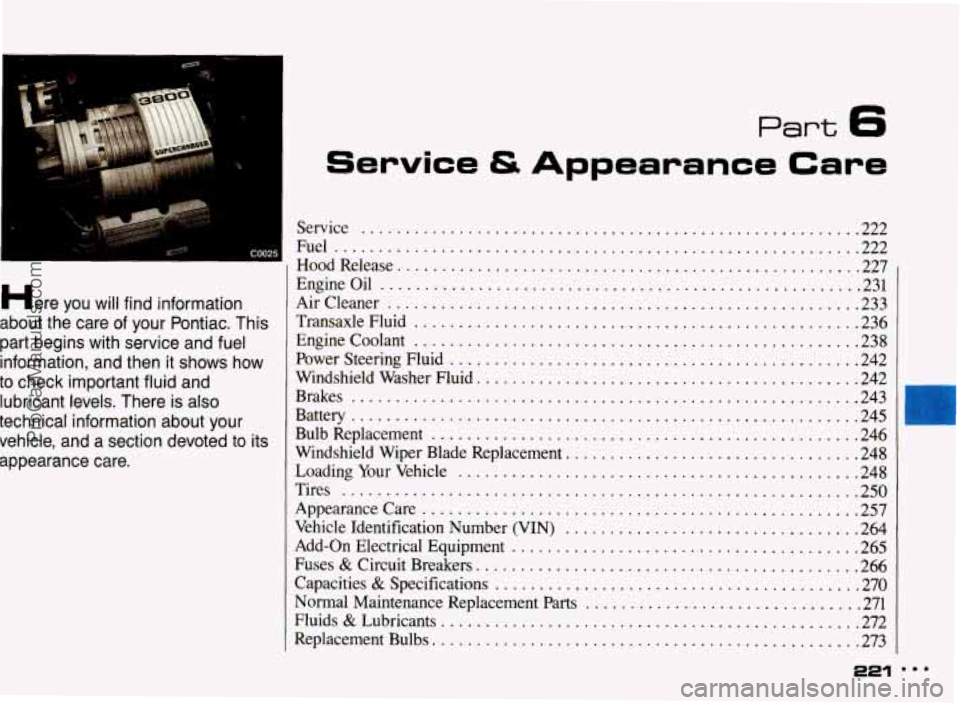
Part 6
I .
COO25
Here you will find information
about the care of your Pontiac
. This
part begins with service and fuel
information. and then it
shows how
to check important fluid and
lubricant levels
. There is also
technical information about your
vehicle. and
a section devoted to its
appearance care
.
Service G Appearance Care
Service ............................. .................. 222
Fuel
......................................................... 222
Engineoil
...................................................... 231
HoodRelease
.................................................... 227
Aircleaner
..................................................... 233
TransaxleFluid
.................................................. 236
Enginecoolant
.................................................. 238
Power Steering Fluid
.............................................. 242
Windshield Washer Fluid
........................................... 242
Bulb Replacement
.............................................. 246
Loading Your Vehicle
............................................. 248
Appearance Care
................................................. 257
Vehicle Identification Number (VIN)
................................. 264
Add-on Electrical Equipment
....................................... 265
Fuses
& Circuit Breakers ........................................... 266
Capacities
& Specifications ......................................... 270
Normal Maintenance Replacement Parts
............................... 271
Fluids
& Lubricants ............................................... 272
Replacement Bulbs
................................................ 273
Brakes
......................................................... 243
Battery
.......................................................... 245
Windshield Wiper Blade Replacement
...................... ....... 248
Tires
.......................................................... 250
221 ...
ProCarManuals.com
Page 223 of 322

Service & Appearance Care
AC’
Service
Your Pontiac dealer knows your vehicle
best and wants you to be happy with
it.
We hope you’ll go to your dealer for all
your service needs. You’ll get genuine
GM parts and GM-trained and
supported service people.
We hope you’ll want to keep your
GM
vehicle all GM. Genuine GM parts have
one of these marks.
Doing Your Own Service Work
If you want to do some of your own
service work, you’ll want to get the
proper Pontiac Service Manual. It
tells you much more about how to service
your Pontiac than this manual can. To
order the proper service manual, see the
Index under Service Publications.
You should keep a record with all parts
receipts and list the mileage and date
of
any service work you perform. See the
Index under Maintenance Record.
I
I You can be injured if you try
to do service work on a
vehicle without knowing enough
about
it.
Be sure you ha! - uffcient
I
knowledge, experience, and the
proper replacement
parts and
tools before you attempt any
vehicle maintenance task.
Be sure to use the proper nuts,
bolts, and other fasteners.
“English” and “metric” fasteners
can be easily confused. If you
use the wrong Edsteners, parts
can later break or fall off. You
could be hup
r
If you try to do service work
without knowing enough about
it,
your vehicle could be damaged.
Fuel
The eighth digit of your Vehicle
Identification Number (VIN) shows the
code letter for your engine.
You will
find the VIN at the top left
of your
instrument panel. (See the
Index under
&hide Identljication Number-.)
3800 Engine (Code L):
Use regular unleaded gasoline rated at
87 octane or higher. It should meet
specifications
ASTM D4814 in the U.S.
and
CGSB 3.5-92 in Canada. These
fuels should have the proper additives,
so you should not have to add anything
to the fuel.
m.. 222
ProCarManuals.com
Page 224 of 322
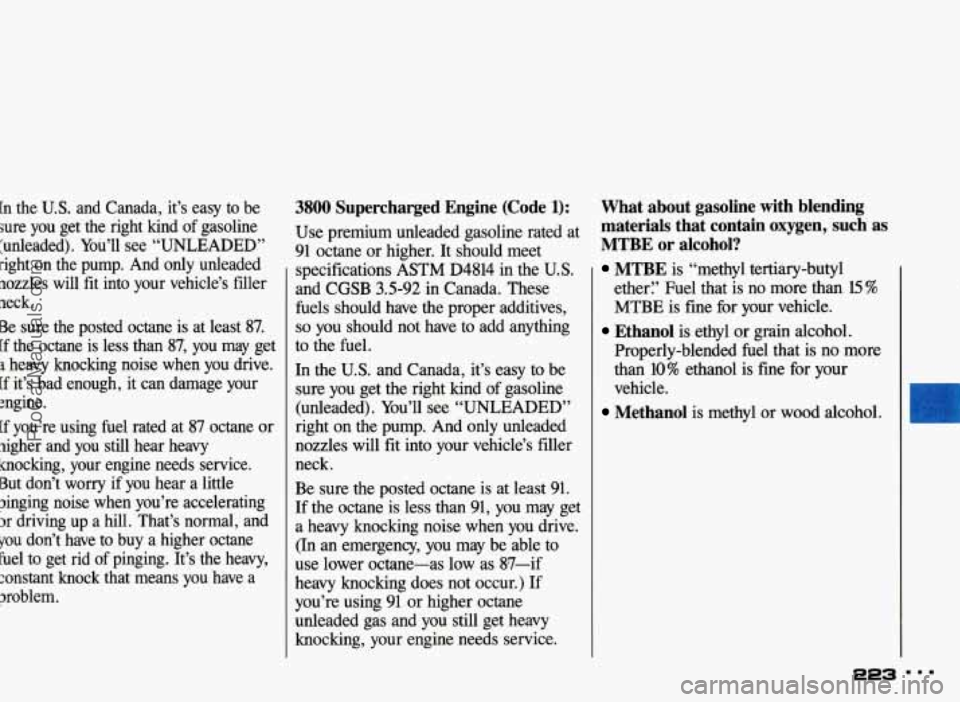
[n the U.S. and Canada, it’s easy to be
sure you get the right kind of gasoline
‘unleaded). You’ll see “UNLEADED”
Pight on the pump. And only unleaded
aozzles will fit into your vehicle’s filler
neck.
Be sure the posted octane is at least
87.
[f the octane is less than 87, you may get
1 heavy knocking noise when you drive.
[fit’s bad enough, it can damage your
:ngine.
[f you’re using fuel rated at 87 octane or
nigher and you still hear heavy
knocking, your engine needs service.
But don’t worry if you hear a little
inging noise when you’re accelerating
3r driving up a hill. That’s normal, and
vou don’t have to buy a higher octane
Fuel to get rid of pinging. It’s the heavy,
:onstant knock that means you have a
xoblem. specifications
ASTM D4814
in the U.S.
and CGSB 3.5-92 in Canada. These
fuels should have the proper additives,
so you should not have to add anything
to the fuel.
In the U.S. and Canada, it’s easy to be
sure you get the right kind of gasoline
(unleaded). You’ll see “UNLEADED”
right on the pump. And only unleaded
nozzles will fit into your vehicle’s filler
neck.
Be sure the posted octane is at least 91.
If the octane is less than 91, you may get
a heavy knocking noise when you drive.
(In an emergency, you may be able to
use lower octane-as low as 87-if
heavy knocking does not occur.) If
you’re using 91 or higher octane
unleaded gas and you still get heavy
knocking, your engine needs service.
MTBE is “methyl tertiary-butyl
ether:’ Fuel that is no more than
15 %
MTBE is fine for your vehicle.
Ethanol is ethyl or grain alcohol.
Properly-blended fuel that is no more
than
10% ethanol is fine for your
vehicle.
Methanol is methyl or wood alcohol.
ProCarManuals.com
Page 225 of 322
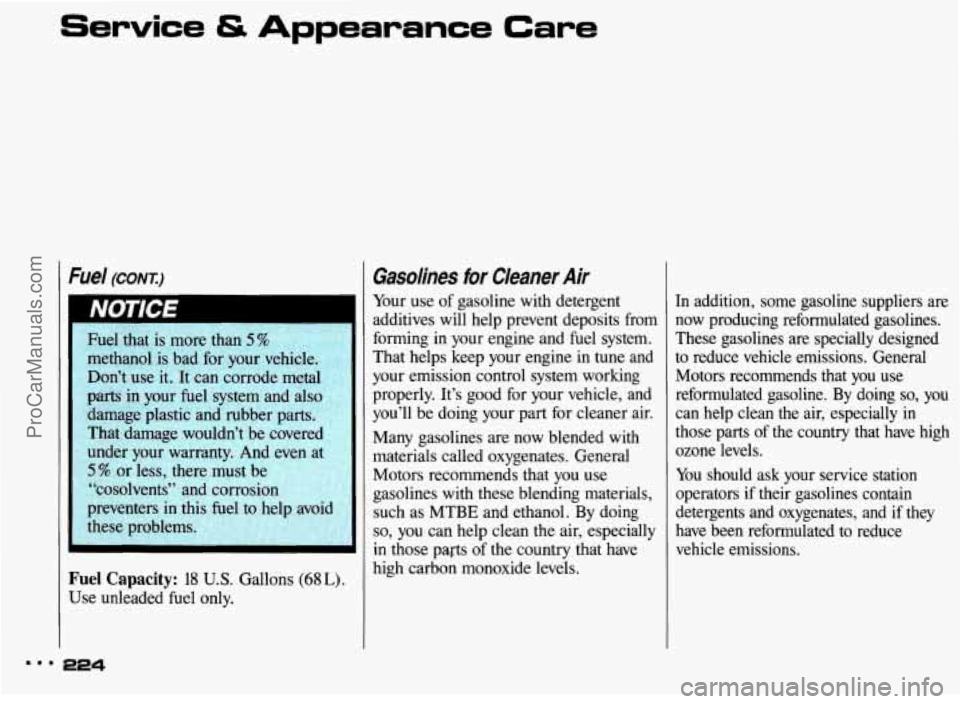
Service & Appearance Care
:#el (CONTI
Fuel that is more than 5 %
methanol is bad for your vehicle.
Don’t use it. It can corrode metal
parts
in your fuel system and also
damage plastic and rubber parts.
That damage wouldn’t be covered
under your warranty. And even at
5% or less, there must be
“cosolvents” and corrosion
preventers
in this fuel to help avoid
these problems.
bel Capacity: 18 U.S. Gallons (68 L).
Ise unleaded fuel only.
Gasolines for Cleaner Air
Your use of gasoline with detergent
additives will help prevent deposits from
forming
in your engine and fuel system.
That helps keep your engine in tune and
your emission control system working
properly. It’s good for your vehicle, and
you’ll be doing your part for cleaner air.
Many gasolines are now blended with
materials called oxygenates. General
Motors recommends that you use
gasolines with these blending materials, such as MTBE and ethanol. By doing
so, you can help clean the air, especially
in those pa@ of the country that have
high carbon monoxide levels. In
addition, some gasoline suppliers are
now producing reformulated gasolines.
These gasolines are specially designed
to reduce vehicle emissions. General
Motors recommends that you use
reformulated gasoline. By doing
so, you
can help clean the air, especially in
those parts of the country that have high
ozone levels.
You should ask your service station
operators
if their gasolines contain
detergents and oxygenates, and if they
have been reformulated to reduce
vehicle emissions.
ProCarManuals.com
Page 226 of 322

Fuels in Foreign Countries
tf you plan on driving in another
country outside the
U.S. or Canada,
unleaded fuel may be hard to find.
Do not use leaded gasoline. If you use
even one tankful, your emission controls
won’t work well or at all. With
continuous use, spark plugs can get
fouled, the exhaust system can corrode,
and your engine oil can deteriorate
quickly. Your vehicle’s oxygen sensor
will be damaged. All of that means
costly repairs that wouldn’t be covered
by your warranty. To
check on fuel availability, ask an auto
club, or contact a major oil company
that does business in the country where
you’ll be driving.
You can also write us at the following
address for advice. Just tell us where
you’re going and give your Vehicle
Identification Number (VIN).
General Motors
of Canada Ltd.
International
Export Sales
P. 0. Box 828
Oshawa, Ontario L1H 7N1, Canada
Fuel Door Lock (omoN)
On SSE and SSEi models equipped with
the Theft-Deterrent System option,
the
fuel door is locked and unlocked
together with the power door locks.
Therefore, to unlock the fuel filler door,
you may use the outside door key lock,
the inside power door lock button, or
the Remote Keyless Entry key chain
transmitter.
To unlock the fuel door, just
unlock the driver’s door.
225
ProCarManuals.com